c-Jun N-terminal kinase 1 phosphorylates Myt1 to prevent UVA-induced skin cancer
- PMID: 19204086
- PMCID: PMC2663297
- DOI: 10.1128/MCB.01508-08
c-Jun N-terminal kinase 1 phosphorylates Myt1 to prevent UVA-induced skin cancer
Abstract
The c-Jun N-terminal kinase (JNK) signaling pathway is known to mediate both survival and apoptosis of tumor cells. Although JNK1 and JNK2 have been shown to differentially regulate the development of skin cancer, the underlying mechanistic basis remains unclear. Here, we demonstrate that JNK1, but not JNK2, interacts with and phosphorylates Myt1 ex vivo and in vitro. UVA induces substantial apoptosis in JNK wild-type (JNK(+/+)) or JNK2-deficient (JNK2(-/-)) mouse embryonic fibroblasts but has no effect on JNK1-deficient (JNK1(-/-)) cells. In addition, UVA-induced caspase-3 cleavage and DNA fragmentation were suppressed by the knockdown of human Myt1 in skin cancer cells. JNK1 deficiency results in suppressed Myt1 phosphorylation and caspase-3 cleavage in skin exposed to UVA irradiation. In contrast, the absence of JNK2 induces Myt1 phosphorylation and caspase-3 cleavage in skin exposed to UVA. The overexpression of JNK1 with Myt1 promotes cellular apoptosis during the early embryonic development of Xenopus laevis, whereas the presence of JNK2 reduces the phenotype of Myt1-induced apoptotic cell death. Most importantly, JNK1(-/-) mice developed more UVA-induced papillomas than either JNK(+/+) or JNK2(-/-) mice, which was associated with suppressed Myt1 phosphorylation and decreased caspase-3 cleavage. Taken together, these data provide mechanistic insights into the distinct roles of the different JNK isoforms, specifically suggesting that the JNK1-mediated phosphorylation of Myt1 plays an important role in UVA-induced apoptosis and the prevention of skin carcinogenesis.
Figures
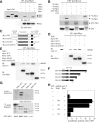


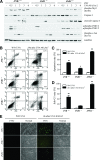
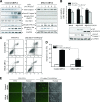
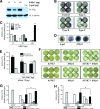
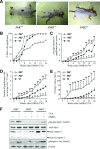
Similar articles
-
c-Jun N-terminal protein kinase 1 (JNK1), but not JNK2, is essential for tumor necrosis factor alpha-induced c-Jun kinase activation and apoptosis.Mol Cell Biol. 2004 Dec;24(24):10844-56. doi: 10.1128/MCB.24.24.10844-10856.2004. Mol Cell Biol. 2004. PMID: 15572687 Free PMC article.
-
Antiapoptotic effect of c-Jun N-terminal Kinase-1 through Mcl-1 stabilization in TNF-induced hepatocyte apoptosis.Gastroenterology. 2009 Apr;136(4):1423-34. doi: 10.1053/j.gastro.2008.12.064. Epub 2009 Jan 6. Gastroenterology. 2009. PMID: 19249395
-
Tumor necrosis factor-induced toxic liver injury results from JNK2-dependent activation of caspase-8 and the mitochondrial death pathway.J Biol Chem. 2006 Jun 2;281(22):15258-67. doi: 10.1074/jbc.M512953200. Epub 2006 Mar 29. J Biol Chem. 2006. PMID: 16571730 Free PMC article.
-
JNK2: a negative regulator of cellular proliferation.Cell Cycle. 2004 Dec;3(12):1520-3. doi: 10.4161/cc.3.12.1315. Epub 2004 Dec 18. Cell Cycle. 2004. PMID: 15611655 Review.
-
The Roles of c-Jun N-Terminal Kinase (JNK) in Infectious Diseases.Int J Mol Sci. 2021 Sep 6;22(17):9640. doi: 10.3390/ijms22179640. Int J Mol Sci. 2021. PMID: 34502556 Free PMC article. Review.
Cited by
-
Sunlight UV-induced skin cancer relies upon activation of the p38α signaling pathway.Cancer Res. 2013 Apr 1;73(7):2181-8. doi: 10.1158/0008-5472.CAN-12-3408. Epub 2013 Feb 4. Cancer Res. 2013. PMID: 23382047 Free PMC article.
-
Activation of p38 MAP kinase and JNK pathways by UVA irradiation.Photochem Photobiol Sci. 2012 Jan;11(1):54-61. doi: 10.1039/c1pp05133d. Epub 2011 Aug 22. Photochem Photobiol Sci. 2012. PMID: 21858326 Free PMC article.
-
JNK Signaling: Regulation and Functions Based on Complex Protein-Protein Partnerships.Microbiol Mol Biol Rev. 2016 Jul 27;80(3):793-835. doi: 10.1128/MMBR.00043-14. Print 2016 Sep. Microbiol Mol Biol Rev. 2016. PMID: 27466283 Free PMC article. Review.
-
Integrative Analysis of MicroRNA and Gene Interactions for Revealing Candidate Signatures in Prostate Cancer.Front Genet. 2020 Feb 27;11:176. doi: 10.3389/fgene.2020.00176. eCollection 2020. Front Genet. 2020. PMID: 32180804 Free PMC article.
-
The Role of the Dysregulated JNK Signaling Pathway in the Pathogenesis of Human Diseases and Its Potential Therapeutic Strategies: A Comprehensive Review.Biomolecules. 2024 Feb 19;14(2):243. doi: 10.3390/biom14020243. Biomolecules. 2024. PMID: 38397480 Free PMC article. Review.
References
-
- Bachelor, M. A., and G. T. Bowden. 2004. UVA-mediated activation of signaling pathways involved in skin tumor promotion and progression. Semin. Cancer Biol. 14131-138. - PubMed
-
- Caffrey, D. R., L. A. O'Neill, and D. C. Shields. 1999. The evolution of the MAP kinase pathways: coduplication of interacting proteins leads to new signaling cascades. J. Mol. Evol. 49567-582. - PubMed
-
- Carter, A. D., and J. C. Sible. 2003. Loss of XChk1 function triggers apoptosis after the midblastula transition in Xenopus laevis embryos. Mech. Dev. 120315-323. - PubMed
Publication types
MeSH terms
Substances
Grants and funding
LinkOut - more resources
Full Text Sources
Other Literature Sources
Medical
Molecular Biology Databases
Research Materials
Miscellaneous
